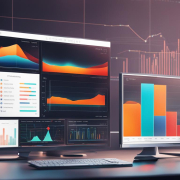Understanding What is IT Monitoring: Vital Guide for Businesses
IT monitoring is a critical practice for businesses to ensure the optimal performance and availability of their IT systems, networks, and applications. By utilizing various tools and techniques, businesses can collect and analyze data to make informed decisions and keep their IT infrastructure running smoothly. IT monitoring provides real-time insights into the IT environment, enabling businesses to identify and resolve issues promptly, enhance data security, and increase operational efficiency.
Key Takeaways:
- IT monitoring is essential for businesses to proactively detect and prevent issues.
- Monitoring key metrics ensures the smooth operation of IT infrastructure.
- IT monitoring plays a vital role in data security and resource optimization.
- Implementing the right IT monitoring solution is crucial for effective monitoring and management.
- Regular analysis, evaluation, and best practices are essential for successful IT monitoring.
Importance of IT Monitoring for Businesses
IT monitoring is of utmost importance for businesses in today’s digital landscape. With the increasing reliance on technology and IT infrastructure, organizations need to ensure that their systems are performing optimally and securely. By implementing effective IT monitoring practices, businesses can proactively detect and address issues before they escalate, minimizing downtime and optimizing operational efficiency.
One of the key benefits of IT monitoring is its ability to provide real-time insights into the performance and availability of critical systems and applications. By monitoring key metrics such as uptime, response time, and resource utilization, businesses can identify potential bottlenecks or inefficiencies and take proactive measures to resolve them. This not only helps improve overall performance but also enhances customer satisfaction, as users experience faster response times and smoother interactions with the organization’s digital platforms.
Furthermore, IT monitoring plays a crucial role in ensuring data security. By monitoring network traffic, detecting unusual activities, and promptly identifying and addressing potential security breaches or vulnerabilities, businesses can protect their sensitive information from unauthorized access. This is particularly vital in industries that deal with sensitive customer data, such as healthcare or finance, where data breaches can have severe consequences.
Implementing IT monitoring strategies also allows businesses to make data-driven decisions. By analyzing monitoring data and identifying trends, organizations can gain valuable insights into their IT infrastructure, capacity planning, and resource allocation. This enables informed decision-making and helps businesses align their IT resources with their operational needs, optimizing costs and ensuring efficient utilization.
The Role of IT Monitoring in Business Continuity
Another crucial aspect of IT monitoring is its role in business continuity. By actively monitoring and managing IT systems and applications, businesses can prevent potential disruptions and ensure the availability of critical services. In today’s highly competitive landscape, where downtime can result in significant revenue losses and reputational damage, IT monitoring becomes a strategic imperative.
Overall, IT monitoring is an essential practice for businesses to maintain the performance, security, and reliability of their IT infrastructure. It enables proactive issue detection, enhances data security, supports informed decision-making, and ensures business continuity. By implementing effective IT monitoring strategies, organizations can navigate the complexities of the digital age with confidence and stay ahead of the competition.
IT Monitoring Tools and Solutions
When it comes to implementing effective IT monitoring, businesses have a range of tools and solutions at their disposal. These tools enable organizations to collect and analyze data from various IT systems, providing real-time insights into system performance. By utilizing these tools, businesses can proactively identify and resolve issues, ensuring their IT infrastructure operates optimally.
Some popular IT monitoring tools include network monitoring tools, server monitoring tools, application performance monitoring (APM) tools, and log management tools. Each tool serves a unique purpose and helps monitor different aspects of the IT environment. For example, network monitoring tools allow businesses to monitor network traffic and identify potential bottlenecks or security threats. Server monitoring tools, on the other hand, provide visibility into the performance and health of server hardware and software.
Implementing the right IT monitoring solution is crucial for businesses to effectively monitor and manage their IT infrastructure. Organizations can choose between on-premises or cloud-based solutions, depending on their specific needs and requirements. Cloud-based solutions offer scalability, flexibility, and cost-effectiveness, making them an attractive option for businesses of all sizes. It is important to carefully evaluate different tools and solutions available in the market to ensure the chosen solution aligns with the organization’s goals and objectives.
| Tool | Function |
|---|---|
| Network Monitoring Tools | Monitors network traffic and identifies performance issues or security threats. |
| Server Monitoring Tools | Provides visibility into the performance and health of server hardware and software. |
| Application Performance Monitoring (APM) Tools | Monitors the performance and availability of applications, helping identify and resolve issues. |
| Log Management Tools | Aggregates and analyzes log data to identify anomalies or potential security breaches. |
Implementing the right IT monitoring tools and solutions allows businesses to effectively monitor their IT infrastructure, detect issues proactively, and ensure optimal performance and availability. By leveraging these tools, organizations can gain valuable insights into their IT environment, make data-driven decisions, and enhance operational efficiency.
You are currently viewing a placeholder content from YouTube. To access the actual content, click the button below. Please note that doing so will share data with third-party providers.
Benefits of IT Monitoring
Implementing IT monitoring brings several benefits to businesses. It helps reduce system downtime by identifying and resolving issues quickly, minimizing the impact on operations. IT monitoring also improves resource utilization, as businesses can identify and optimize over or underutilized resources. By monitoring key performance indicators, businesses can identify trends, forecast future needs, and plan capacity accordingly. IT monitoring also enhances data security by detecting and preventing potential breaches, ensuring the confidentiality, integrity, and availability of sensitive information.
One of the key benefits of IT monitoring is its ability to minimize system downtime. By continuously monitoring IT infrastructure, businesses can identify and resolve issues promptly, reducing the time it takes to get systems up and running again. This ensures that operations are not disrupted, maintaining a smooth workflow and preventing revenue loss. With real-time insights provided by IT monitoring, businesses can take proactive measures to address potential issues before they escalate, ensuring uninterrupted operations.
Furthermore, IT monitoring helps optimize resource utilization within businesses. By monitoring the performance of IT systems and applications, organizations can identify overutilized or underutilized resources. This enables them to allocate resources effectively, ensuring that they are utilized in the most efficient manner. By optimizing resource utilization, businesses can improve operational efficiency, reduce costs, and make better use of their IT infrastructure.
Another significant benefit of IT monitoring is its role in enhancing data security. With the increasing frequency and sophistication of cyber threats, businesses need robust security measures to protect their sensitive information. IT monitoring helps businesses detect and prevent potential security breaches by continuously monitoring network traffic, identifying unusual activities, and implementing appropriate security measures. By ensuring the confidentiality, integrity, and availability of data, businesses can maintain the trust of their customers, avoid reputational damage, and comply with regulatory requirements.
| Benefits of IT Monitoring | Description |
|---|---|
| Minimizes system downtime | Identifies and resolves issues quickly, reducing the impact on operations |
| Optimizes resource utilization | Identifies overutilized or underutilized resources, improving operational efficiency |
| Improves capacity planning | Monitors key performance indicators, identifies trends, and forecasts future needs |
| Enhances data security | Detects and prevents potential security breaches, ensuring confidentiality, integrity, and availability of sensitive information |
Best Practices for IT Monitoring
Implementing best practices for IT monitoring is crucial for businesses to ensure the effectiveness and efficiency of their monitoring efforts. By following these practices, organizations can proactively detect and resolve issues, optimize resource utilization, and enhance data security. Here are some key best practices for IT monitoring:
1. Define Clear Monitoring Objectives
To start, it is essential to define clear objectives for your IT monitoring efforts. Identify what aspects of your IT infrastructure you want to monitor, such as network performance, server uptime, or application response time. By setting specific goals, you can focus your monitoring efforts and gather meaningful insights.
2. Identify Critical Systems and Applications
Not all systems and applications are equally important to monitor. Identify the critical ones that directly impact your business operations and prioritize their monitoring. By focusing on the most critical components of your IT infrastructure, you can allocate resources effectively and respond promptly to any issues.
3. Set Up Proper Alerting Mechanisms
Alerts play a vital role in IT monitoring, as they notify you when issues or abnormalities are detected. Set up proper alerting mechanisms to ensure timely notifications for critical events. Configure alerts based on predefined thresholds or anomaly detection algorithms, allowing you to take immediate action when necessary.
4. Regularly Review and Update Monitoring Configurations
IT environments are dynamic, and monitoring configurations must keep up with changes. Regularly review and update your monitoring configurations to ensure they remain relevant and accurate. This includes adding new systems or applications to monitor and adjusting thresholds based on changing requirements.
By following these best practices, businesses can establish an effective IT monitoring strategy. It is important to remember that IT monitoring is an ongoing process that requires continuous evaluation and improvement. By staying proactive and adapting to evolving technologies and business needs, organizations can maximize the benefits of IT monitoring and ensure the smooth operation of their IT infrastructure.
Implementing IT Monitoring Techniques
Implementing effective IT monitoring techniques is crucial for businesses to ensure the optimal performance and security of their IT infrastructure. By utilizing these techniques, organizations can proactively detect and resolve issues, improve resource utilization, and make informed decisions based on real-time insights. Here are some key IT monitoring techniques to consider:
Real-time Monitoring for Key Performance Indicators
Real-time monitoring allows businesses to track and analyze key performance indicators (KPIs) continuously. By monitoring metrics such as server uptime, network response time, and application performance, organizations can identify potential bottlenecks or anomalies and take proactive measures to address them. Real-time monitoring provides valuable insights into the health and performance of critical IT systems, enabling businesses to ensure smooth operations and mitigate the risk of downtime.
Automated Monitoring with Alerts and Notifications
Implementing automated monitoring tools that provide alerts and notifications is essential for efficient IT monitoring. These tools can detect and notify IT teams about any performance issues, security breaches, or anomalies in real-time. By automating the monitoring process, businesses can reduce manual effort and ensure quick response times. Alerts and notifications can be customized based on severity levels, ensuring that the right personnel are notified promptly to resolve any issues before they impact operations.
Predictive Analytics for Proactive Issue Detection
Predictive analytics leverages historical data and machine learning algorithms to identify potential issues before they occur. By analyzing patterns and trends, organizations can predict system failures, capacity limitations, or security vulnerabilities, allowing them to take preventive measures in advance. Predictive analytics can help businesses optimize resource allocation, plan for future needs, and minimize the risk of downtime or performance degradation.
Implementing these IT monitoring techniques can significantly enhance an organization’s monitoring capabilities and ensure the stability and security of their IT infrastructure. By continuously monitoring KPIs, automating the monitoring process, and leveraging predictive analytics, businesses can stay ahead of potential issues, make informed decisions, and achieve better overall performance and customer satisfaction.
IT Monitoring Best Practices for Data Security
When it comes to data security, implementing best practices for IT monitoring is crucial. By following these practices, businesses can proactively identify and mitigate security risks, protect sensitive information, and ensure the integrity of their IT infrastructure.
One of the key best practices is to monitor network traffic for unusual activities. By analyzing network logs and using intrusion detection systems, businesses can detect and respond to potential security breaches promptly. Additionally, implementing firewalls and regularly conducting vulnerability assessments can help fortify the network against malicious attacks.
“Monitoring network traffic and implementing intrusion detection systems are essential practices for ensuring data security.”
Another important best practice is to establish proper access controls. Businesses should regularly review and update user access permissions, ensuring that only authorized individuals have access to sensitive information. Regularly backing up data is also crucial to protect against data loss or corruption, providing an additional layer of security.
Lastly, educating employees about cybersecurity best practices is essential. By training staff on topics such as password security, phishing awareness, and safe browsing habits, businesses can minimize the risk of human error leading to security breaches.
Effective IT Monitoring Strategies
Implementing effective IT monitoring strategies can greatly enhance data security. By investing in robust monitoring tools and solutions, businesses can gain real-time visibility into their IT environment and detect and respond to potential security incidents promptly.
Some key strategies for successful IT monitoring include:
- Defining clear monitoring objectives and identifying critical systems and applications to monitor.
- Setting up proper alerting mechanisms to receive notifications of potential security incidents.
- Regularly reviewing and updating monitoring configurations to align with changing business needs.
- Establishing a centralized monitoring dashboard to provide a comprehensive view of the entire IT environment.
- Regularly analyzing and evaluating monitoring data to identify trends and potential security vulnerabilities.
By implementing these strategies, businesses can ensure proactive monitoring, early detection of security threats, and effective incident response.
| Best Practices for Data Security | Effective IT Monitoring Strategies |
|---|---|
| Monitor network traffic for unusual activities | Define clear monitoring objectives |
| Implement intrusion detection systems and firewalls | Set up proper alerting mechanisms |
| Regularly conduct vulnerability assessments | Regularly review and update monitoring configurations |
| Establish proper access controls | Establish a centralized monitoring dashboard |
| Regularly back up data | Analyze and evaluate monitoring data |
| Educate employees about cybersecurity best practices |
By combining best practices for data security with effective IT monitoring strategies, businesses can create a robust security posture that safeguards their valuable data and protects against potential threats.
Strategies for Successful IT Monitoring Implementation
Implementing IT monitoring is a strategic decision that requires careful planning and execution. To ensure a successful implementation, we recommend following these strategies:
1. Define Clear Monitoring Goals and Objectives
Before implementing IT monitoring, it is essential to define clear goals and objectives. Identify the specific areas and systems that need to be monitored to meet your organization’s needs and requirements. This will help you focus your monitoring efforts and ensure that you are collecting relevant data for analysis.
2. Evaluate and Choose the Right Monitoring Tools
There are various IT monitoring tools and solutions available in the market. Evaluate different options based on your organization’s requirements and choose the one that best fits your IT environment. Consider factors such as ease of use, scalability, flexibility, and integration capabilities to make an informed decision.
3. Configure and Customize the Monitoring Tool
Once you have selected a monitoring tool, it is crucial to properly configure and customize it to align with your organization’s needs. Define monitoring thresholds, set up alerting mechanisms, and customize dashboards to ensure that you are monitoring the right metrics and receiving timely notifications for any issues.
4. Regularly Review and Update Monitoring Configurations
IT environments are dynamic, and monitoring configurations need to be regularly reviewed and updated. As your organization’s needs change, ensure that your monitoring configurations align with these changes. Regularly assess the effectiveness of your monitoring strategies and make necessary adjustments to optimize the monitoring process.
| Strategies for Successful IT Monitoring Implementation | Benefits |
|---|---|
| Define Clear Monitoring Goals and Objectives | Focus monitoring efforts |
| Evaluate and Choose the Right Monitoring Tools | Optimal tool selection |
| Configure and Customize the Monitoring Tool | Accurate and relevant monitoring data |
| Regularly Review and Update Monitoring Configurations | Optimized monitoring process |
Implementing these strategies will help ensure the successful implementation of IT monitoring in your organization. By defining clear goals, selecting the right tools, customizing the monitoring process, and regularly reviewing configurations, you can proactively monitor your IT infrastructure and make informed decisions for better business outcomes.
Monitoring the Future: Advancements in IT Monitoring
As technology continues to evolve, so does the field of IT monitoring. Advancements in IT monitoring techniques, solutions, and tools are shaping the future of this practice, bringing new opportunities and challenges for businesses. One of the key advancements is the integration of artificial intelligence (AI) and machine learning (ML) technologies. AI and ML algorithms can analyze vast amounts of monitoring data, identify patterns, and detect anomalies more efficiently than traditional methods.
Cloud-based monitoring solutions are also gaining momentum. These solutions offer scalability, flexibility, and cost-effectiveness, allowing businesses to monitor their IT infrastructure from anywhere, anytime. With cloud-based monitoring, organizations can easily expand their monitoring capabilities as their IT environment grows.
The rise of the Internet of Things (IoT) devices has brought a new dimension to IT monitoring. Businesses now need to monitor not only their traditional IT systems but also IoT devices to ensure their performance and security. IoT monitoring solutions are emerging to address this challenge, providing businesses with insights into the performance, availability, and security of their IoT devices.
| Advancements in IT Monitoring | Benefits |
|---|---|
| Integration of AI and ML technologies | Efficient analysis of monitoring data, improved anomaly detection |
| Cloud-based monitoring solutions | Scalability, flexibility, cost-effectiveness |
| IoT monitoring solutions | Insights into performance, availability, and security of IoT devices |
These advancements in IT monitoring present businesses with an opportunity to enhance their monitoring capabilities and stay ahead in the ever-changing technological landscape. By leveraging AI and ML technologies, organizations can gain deeper insights into their IT infrastructure’s performance, predict and prevent issues, and optimize resource utilization. Cloud-based monitoring solutions enable businesses to have a holistic view of their IT environment, irrespective of physical locations. IoT monitoring solutions empower organizations to monitor and manage the performance and security of their IoT devices, ensuring smooth operations.
To stay competitive and ensure the effectiveness of IT monitoring, businesses need to embrace these advancements and adapt their monitoring strategies accordingly. By staying updated with the latest technologies and solutions, organizations can proactively address emerging IT challenges and make data-driven decisions for better business outcomes.
Conclusion
In conclusion, IT monitoring is a vital practice for businesses to ensure the optimal performance of their IT infrastructure and achieve various benefits. By implementing effective monitoring tools and solutions, organizations can proactively detect and resolve issues, minimize system downtime, and enhance operational efficiency.
IT monitoring also plays a crucial role in improving data security by identifying potential breaches and vulnerabilities. With the ability to monitor key metrics and analyze trends, businesses can make data-driven decisions, optimize resource utilization, and plan for future needs.
Investing in IT monitoring is a strategic decision that can have a significant impact on a business’s overall success. By following best practices, staying updated with advancements in IT monitoring, and leveraging innovative technologies, organizations can stay ahead of the curve and ensure the smooth functioning of their IT environment.
With the continuous evolution of IT monitoring, including advancements in artificial intelligence, machine learning, and cloud-based solutions, businesses have opportunities to further enhance their monitoring capabilities and adapt to emerging trends. As the digital landscape continues to evolve, IT monitoring remains a critical discipline, empowering businesses to overcome challenges and achieve their goals.
FAQ
What is IT monitoring?
IT monitoring is the practice of monitoring and managing the performance and availability of IT systems, networks, and applications. It involves using tools and techniques to collect data, analyze it, and make informed decisions to ensure optimal functioning of IT infrastructure.
Why is IT monitoring important for businesses?
IT monitoring is crucial for businesses in today’s digital age as it helps organizations proactively detect and prevent issues before they impact critical systems and operations. It also helps improve performance, enhance data security, and increase operational efficiency.
What are some popular IT monitoring tools?
Some popular IT monitoring tools include network monitoring tools, server monitoring tools, application performance monitoring (APM) tools, and log management tools. These tools can be implemented on-premises or in the cloud, depending on the organization’s requirements.
What are the benefits of IT monitoring?
IT monitoring helps reduce system downtime, improve resource utilization, enhance data security, optimize IT resources, improve customer satisfaction, and make data-driven decisions for better business outcomes.
What are the best practices for IT monitoring?
Best practices for IT monitoring include defining clear monitoring objectives, identifying critical systems and applications to monitor, setting up proper alerting mechanisms, establishing a centralized monitoring dashboard, regularly reviewing and updating monitoring configurations, conducting performance tests, and implementing proper incident response processes.
What techniques can be used for implementing effective IT monitoring?
Techniques for effective IT monitoring include setting up real-time monitoring for key performance indicators, implementing automated monitoring tools that provide alerts and notifications, and utilizing predictive analytics to identify potential issues before they occur.
How does IT monitoring ensure data security?
IT monitoring helps ensure data security by monitoring network traffic for unusual activities, implementing intrusion detection systems and firewalls, conducting regular vulnerability assessments, establishing proper access controls, regularly backing up data, and educating employees about cybersecurity best practices.
What strategies are important for successful IT monitoring implementation?
Strategies for successful IT monitoring implementation include defining monitoring goals and objectives, evaluating and selecting the right monitoring tools and solutions, configuring and customizing the selected tool, regularly reviewing and updating monitoring configurations, and continuously enhancing monitoring capabilities.
What are the future advancements in IT monitoring?
The future of IT monitoring includes the integration of artificial intelligence (AI) and machine learning (ML) technologies for advanced analytics and predictive monitoring. Cloud-based monitoring solutions and the increasing adoption of Internet of Things (IoT) devices also present new challenges and opportunities for IT monitoring.
Why should businesses invest in IT monitoring?
Investing in IT monitoring is a strategic decision that can have a significant impact on a business’s overall success. It helps ensure optimal performance of IT infrastructure, enhance data security, improve operational efficiency, and make data-driven decisions for better business outcomes.
Source Links
- https://infiniummedical.com/the-core-guide-to-vital-sign-monitoring/
- https://www.ncbi.nlm.nih.gov/books/NBK553213/
- https://www.hopkinsmedicine.org/health/conditions-and-diseases/vital-signs-body-temperature-pulse-rate-respiration-rate-blood-pressure
- About the Author
- Latest Posts
Mark is a senior IT technician at Biteno.com . He writes about Linux, Windows and Software.









